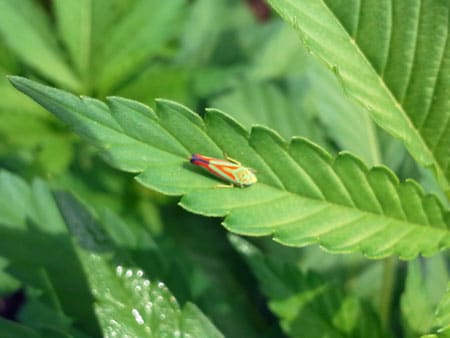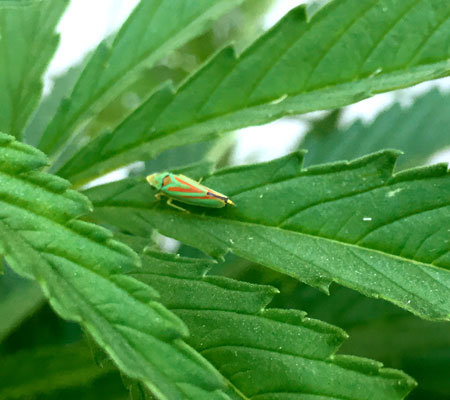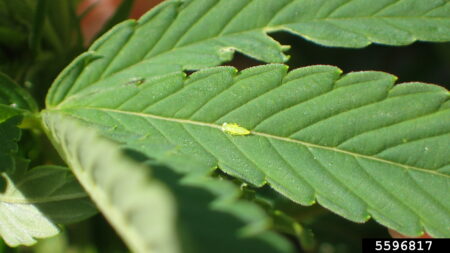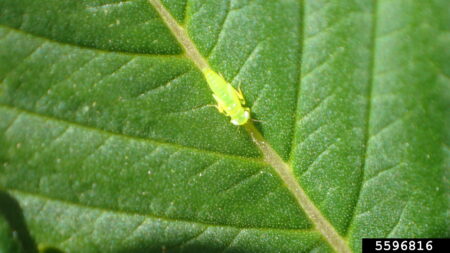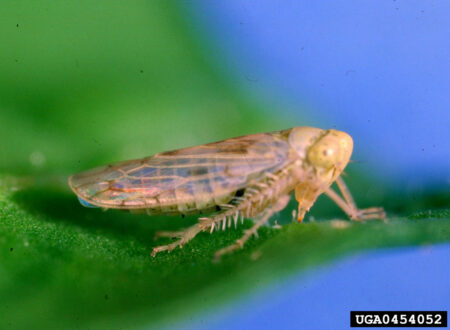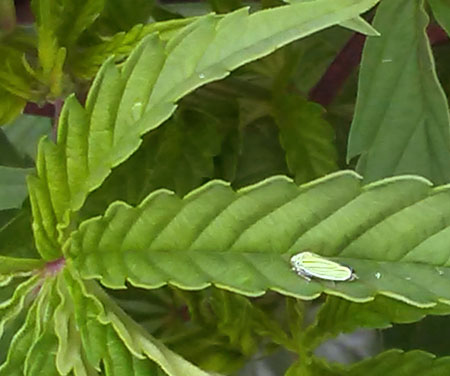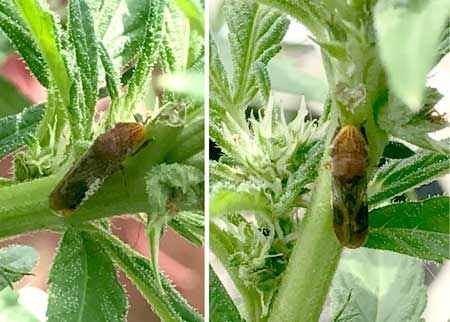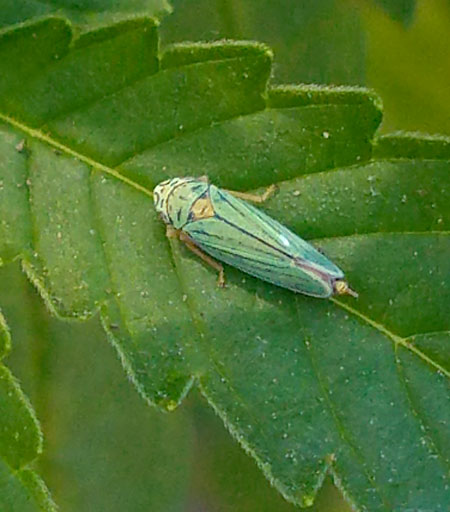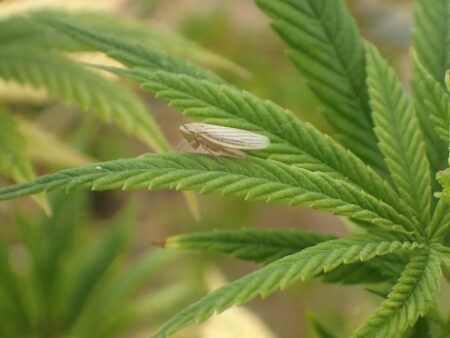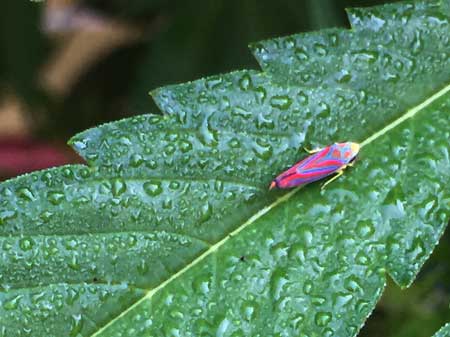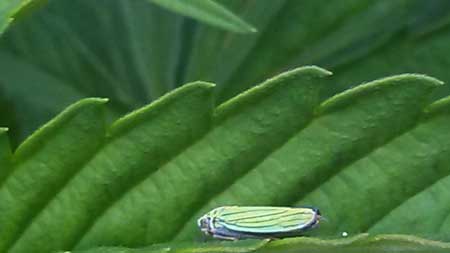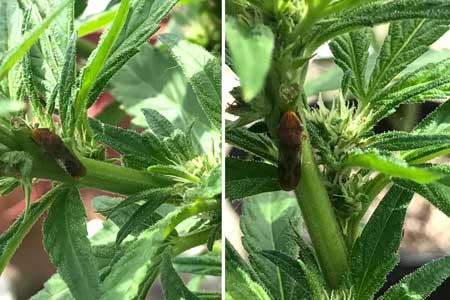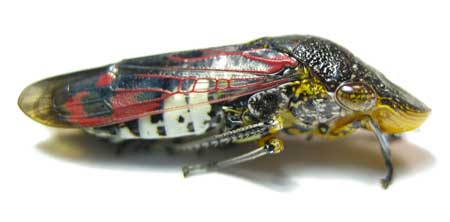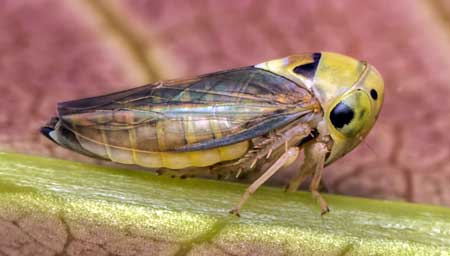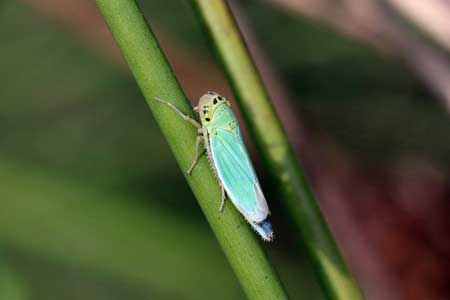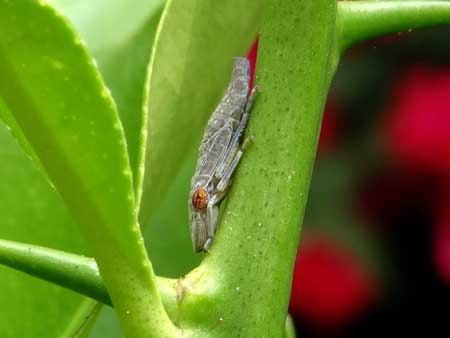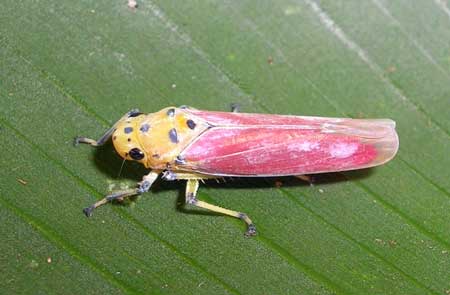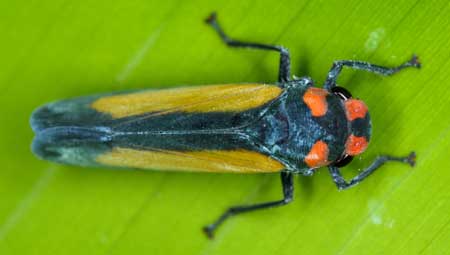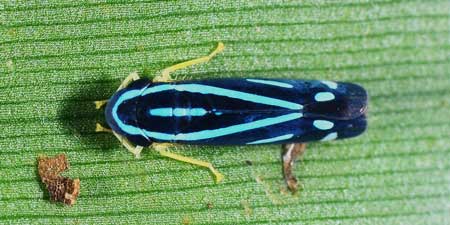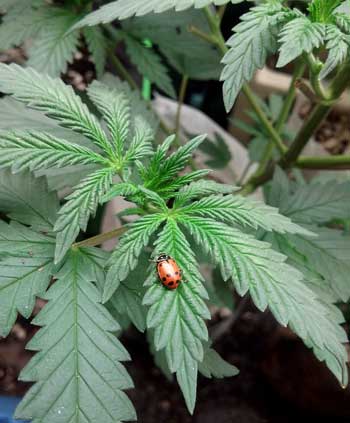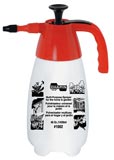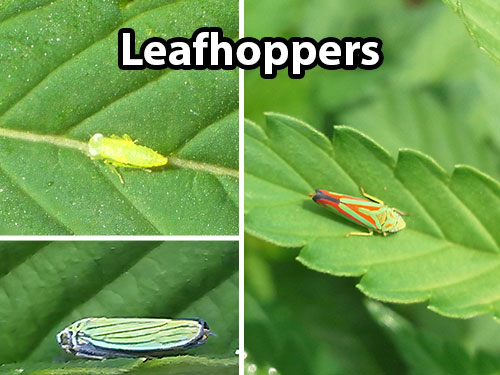
by Nebula Haze
Table of Contents
What Do Leafhoppers Look Like?
Solution: How to Get Rid of Leafhoppers
Does your cannabis plant have leafhoppers? Is it suffering from “Weed Hopperburn Disorder”? Do you see white specks on leaves? Leafhoppers are cannabis pests for outdoor growers. Many species of leafhoppers happily munch on your marijuana leaves or mate on your cannabis plants. Depending on the species they may leave spots on the leaves. If the pest is a potato leafhopper, it may cause a disorder known as “hopperburn” which causes the ends of leaves to die. Beet leafhoppers can also spread certain plant diseases like beet curly top virus, so get rid of leafhoppers quick!
The following leafhopper is a very common type of leafhopper known officially as Graphocephala coccinea but common names include: “candy-striped” leafhopper, “red-banded” leafhopper, “scarlet and green” leafhopper and “red and blue” leafhopper.
This leafhopper is a very common type of leafhopper found on cannabis plants in North and Central America. Often accompanied by white specks on the cannabis leaves.
The potato leafhopper from the eastern U.S. is a common outdoor cannabis pest (thanks to Whitney Cranshaw for these images). This is a potato leafhopper nymph (not the adult form).
Another example of the potato leafhopper in nymph form.
The beet leafhopper is a common host for Beet Curly Top Virus, and easily spreads the disease while feeding. Photographer: A.C. Magyarosy
Nymph of a different leafhopper species (Ceratagallia uhleri)
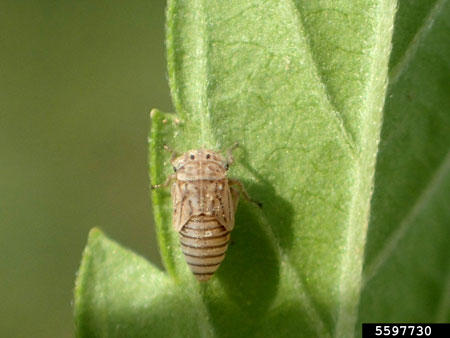
Potato leafhopper damage (“hopperburn”) on a cannabis plant – This was in the eastern U.S. from a potato leafhopper (Emposaca fabae). These leafhoppers feed on the plant’s inner juices, which seems to be toxic to some strains of cannabis. Most other plants in the same field were unaffected. Check out this PDF information sheet about hopperburn from Whitney Cranshaw of Colorado State University.
Note: Only the potato leafhopper causes “hopperburn” looks like this. I have not seen examples of other leafhoppers causing these symptoms.
There are at least 20,000 different types of leafhoppers, and they can come in lots of different variations from solid to stripes. Colors can range from bright red, green, yellow, blue, pink, torquoise, purple, brown, tan, and even black.
This green striped leafhopper is common on hemp plants
Some leafhoppers are dark colored
This is the “blue green sharpshooter” bug, which can carry diseases to cannabis plants.
These tan leafhoppers (beet leafhoppers) spread diseases and viruses to cannabis plants (image credit: Colorado State University)
Leafhoppers are more likely to strike your plants when it’s dry, as they want moisture from the leaves.
When it comes to getting rid of leafhoppers, it doesn’t matter which type of leafhopper you have, because the remedies will work on all species. If you see leafhoppers, the remedies below should get rid of them.
Pictures of More Leafhoppers
Different types of leafhoppers can look very different from each other so it can be difficult to identify them sometimes. To make things even more confusing, each species has different forms depending on the current stage of life.
The shape of their head and bodies can be different, but the overall structure of leafhoppers always stay the same no matter what species is attacking your marijuana plants.
- They have 6 legs. You can usually see two sets of legs from above, but often one set can appear hidden or more difficult to see. The back legs are often hairy or jagged looking, and are used to help the bug jump
- They have wings that lay flat against the body
- They sort of “slide” sideways when they move, often hiding from you by flipping to the other side of the leaf when they catch you looking
- They also jump as I’m sure you’d expect by their name 🙂
Other examples of leafhoppers (different species and stages of life)
Notice how with the following two examples you can’t really see the third set of legs from above, so it looks like each bug only has four legs. This can sometimes be confusing if you’re looking for an insect with 6 legs!
Now that you know you’ve got leafhoppers on your cannabis plants, how do you get rid of them?
Solution: How to Get Rid of Leafhoppers on Cannabis
Leafhoppers suck sap out of your cannabis leaves, and you don’t want that! If it’s just one or two bugs you may not notice any symptoms but if your plants start getting infested with leafhoppers you’ll noticed tons of spots where they have been biting your leaves. If you let an infestation get out of hand your affected leaves will start yellowing and dying.
1.) Check regularly for signs of leafhoppers, especially when it’s dry
The best way to prevent a leafhopper infestation (or any bug infestation really) is to catch them as soon as possible. Leafhoppers will suck sap moisture out of cannabis leaves most often when it’s dry, because they get thirsty, so that’s a good time to check.
Make sure to look under leaves and all around the plants, as they will try to hide from you, often gliding across the leaf to the other side so you can’t see it.
2.) Spinosad (not for commercial growers)
Spinosad Products (safe & organic) – Spinosad products are organic and completely harmless to pets, children, and plants. Spinosad products can be used directly to kill leafhoppers on contact and should be sprayed liberally anywhere you see leafhoppers, especially under the leaves. Although maybe not as strong against pests as some of the more harsh insecticides, it does work and it’s very safe for plants, animals, and humans!
WARNING: Commercial growers click here!
Recommended: Monterey Garden Insect Spray with Spinosad
Spinosad is an organic insecticide made from the fermentation of a specific soil bacteria (actinomycete Saccharopolyspora spinosa) and kills leafhoppers via ingestion or contact by effecting the insect’s nervous system. Spinosad can be a good choice for organic and outdoor growers, because it is very toxic to leafhoppers, but is less toxic to many beneficial insects, bug predators and spiders.
Note: Most spinosad products are effective for only about 24 hours after being mixed with water, so only mix as much as you will need per application. Anything left over will be waste.
You will need a mister (also called a “One-Hand Pressure Sprayer”) to cover all the leaves evenly when spraying them with spinosad products.
3.) Insecticidal soaps
Fatty acid salts or insecticidal soaps can be a good choice against leafhoppers. They weaken the outer shell of leafhoppers but are safe to use on your plants and they don’t leave much of a residue which could kill beneficial bugs in your garden.
With soaps, coverage is very important as it does not stay on your plant for long, so follow-up applications may be necessary. Although this is considered safe, avoid getting any on your buds!
4.) Neem Oil
Neem Oil will leave an unpleasant taste/smell on buds when used to treat flowering plants, so again, don’t let this stuff get near your buds! There’s also some evidence Neem oil may be harmful to humans so use with care! That being said, Neem oil is an all-natural remedy that is very effective against many different types of bugs and mold, including leafhoppers. You will need a mister (also called a “One-Hand Pressure Sprayer”) to spray all the leaves evenly, since neem oil and water can separate easily.
5.) Beneficial Insects
Beneficial insects, such as lady beetles, parasitic wasps, lady bugs, and lacewings may eat large numbers of leafhoppers and are welcome guests in the garden. Although you can order beneficial insects to release around your plants, they do tend to fly away in just a day or two.
Ladybugs are good insects to have around the garden – they eat leafhoppers and other annoying cannabis pests
6.) Floating row covers
These may not be the best choice for all cannabis growers, but these are very cheap and effective against leafhoppers because it physically prevents them from getting to your plants, while still letting light in to your plants. You can also water your plants through the netting. These are sometimes used to make mini “green houses” on the plants, or some grower will just drap them over the plant as they’re so light and airy they don’t really bother the plant.
However, these are much easier to use and are more effective with smaller plants, as it becomes difficult to fully cover larger plants. However, for young plants these can be great! They also protect your plant from wind and some harsh conditions.
Floating row covers look like thin netting or mesh
7.) Pyrethrin
Pyrethrin based insecticides are not very toxic for humans, and therefore they’re commonly recommended for vegetable gardens. You will need a mister (also called a “One-Hand Pressure Sprayer”) to spray all the leaves evenly since pyrethrin concentrate and water can separate easily.
Pyrethrin products break down quickly, over the course of just a day or two. The major problem with them is they are very toxic to bees. Although cannabis plants generally don’t attract a lot of bees, please use this as a last resort, and also try to use it right after the sun goes down because bees sleep at night. This lets it start to break down before they wake up.
Use pyrethrin products as the sun goes down to help reduce possible harm to bees.
A popular example is Bonide 857 Pyrethrin Spray Concentrate. Use 3 tablespoons of concentrate per gallon of water.

